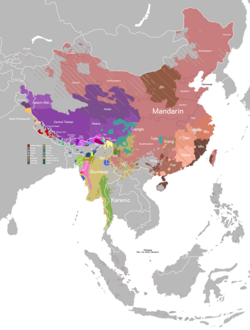Ganan language
In today's world, Ganan language has captured the attention and interest of a large number of people. Whether due to its impact on society, its relevance in history, its influence on popular culture or its importance in the professional field, Ganan language has become a topic of great interest to a wide audience. Learning more about Ganan language is not only a way to expand our knowledge, but also to better understand the world around us. In this article we will explore various aspects related to Ganan language, analyzing its origin, its evolution over time, its impact in different areas and the future perspectives that this topic presents to us.
| Ganan | |
|---|---|
| Kanan | |
| Native to | Myanmar |
| Region | Sagaing Region |
Native speakers | 9,000 (2007)[1] |
| Language codes | |
| ISO 639-3 | zkn |
| Glottolog | gana1267 |
| ELP | Kanan |
Ganan (Burmese: ကနန်း; also spelled as Ganaan or Kanan) is a Sino-Tibetan language of northwestern Myanmar, spoken in Sagaing Region.[2] It belongs to the Luish branch, and is most closely related to the Kadu language of Myanmar, with which it shares 84 to 89% lexical similarity.[2] The Ganan dialects share 95 to 99% lexical similarity.[2]
Phonology
Vowels
| Front | Central | Back | |
|---|---|---|---|
| Close | i | u | |
| Close-mid | e | o | |
| Open-mid | ɛ | ɜ | ɔ |
| Open | a |
Consonants
| Bilabial | Alveolar | Alveolo-palatal | Palatal | Velar | Glottal | ||
|---|---|---|---|---|---|---|---|
| Stop | Voiceless | p | t | k | ʔ | ||
| Voiced | b | d | ɡ | ||||
| Fricative | Voiceless | s | ɕ | h | |||
| Voiced | z | ʑ | |||||
| Nasal | m | n | ɲ | ŋ | |||
| Approximant | l | j | w | ||||
Names
Ethnologue lists Ganaan, Ganan, Ganon, Genan, Kanan as alternate names.
Distribution
According to Ethnologue, as of 2007 Ganan is spoken in 24 villages of Banmauk Township along the Mu River by 9,000 people in Katha District, Sagaing Region, Myanmar.[2] It is also located in a few villages in Homalin, Indaw, and Pinlebu townships.[2]
References
- ^ Ganan at Ethnologue (18th ed., 2015) (subscription required)
- ^ a b c d e "Myanmar". Ethnologue: Languages of the World. 2016. Archived from the original on 2016-10-10.
- Huziwara, Keisuke 藤原, 敬介. 2012. Rui sogo no saikou ni mukete ルイ祖語の再構にむけて . In Kyoto University Linguistic Research 京都大学言語学研究 (2012), 31: 25-131. doi:10.14989/182194
- Matisoff, James A. 2013. Re-examining the genetic position of Jingpho: putting flesh on the bones of the Jingpho/Luish relationship. Linguistics of the Tibeto-Burman Area 36(2). 1–106.
